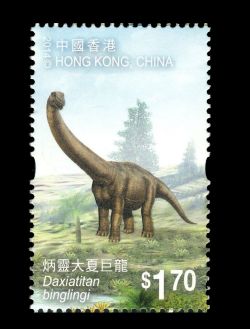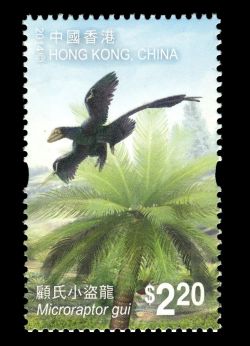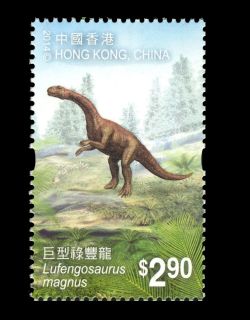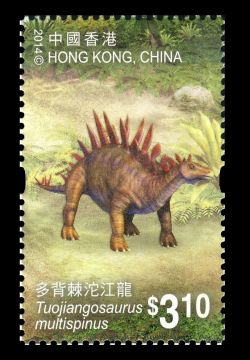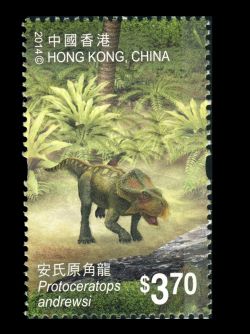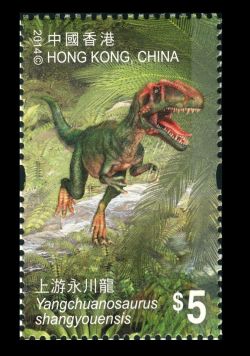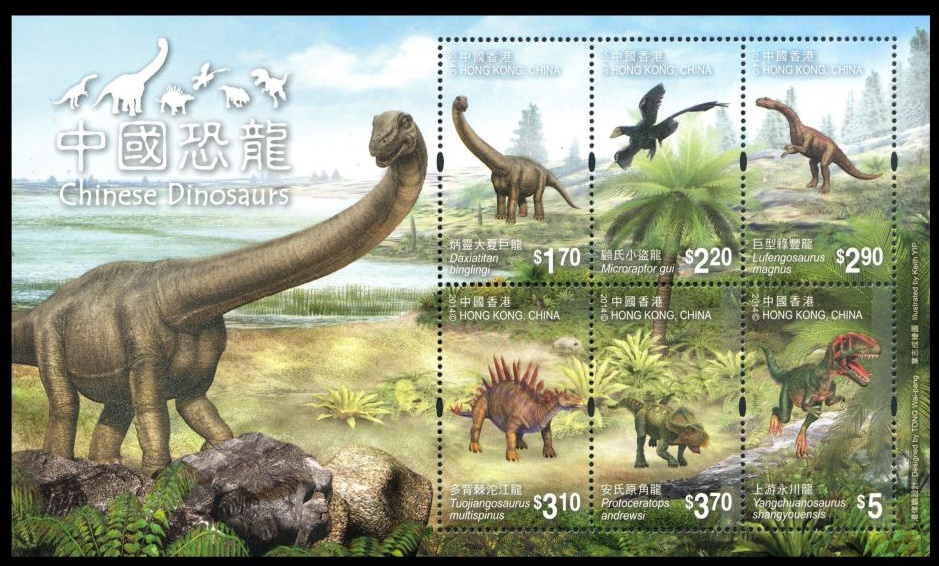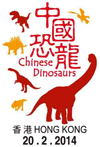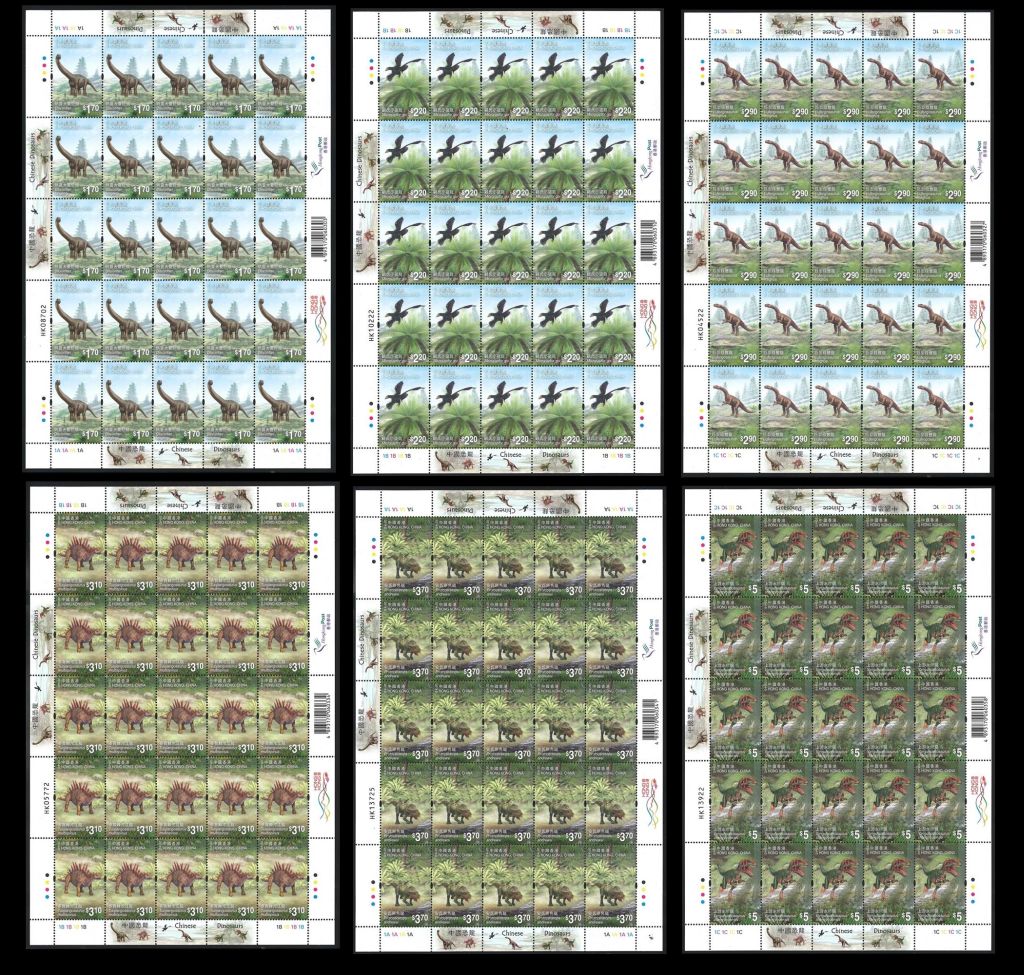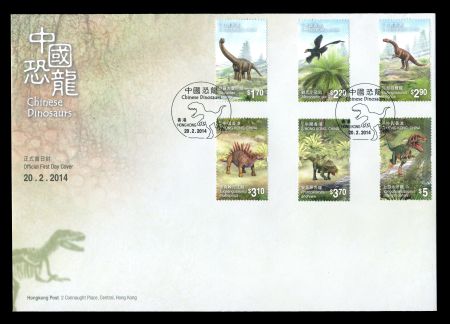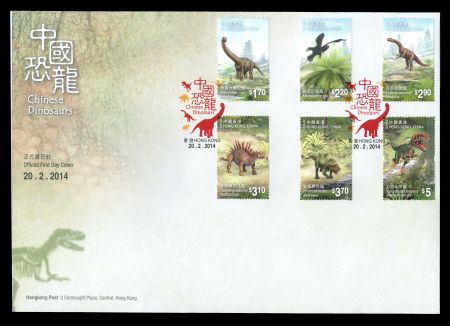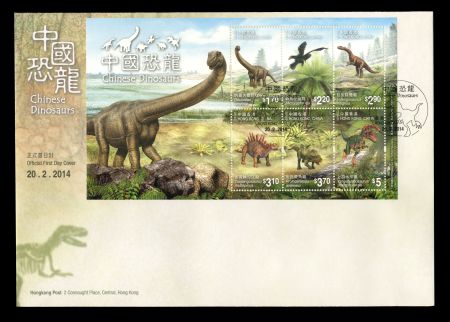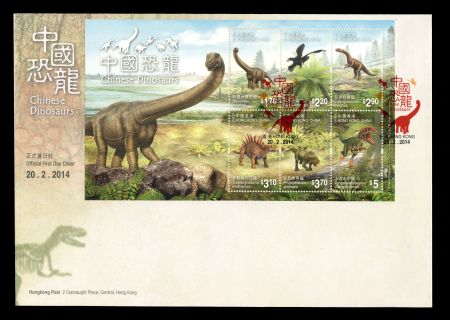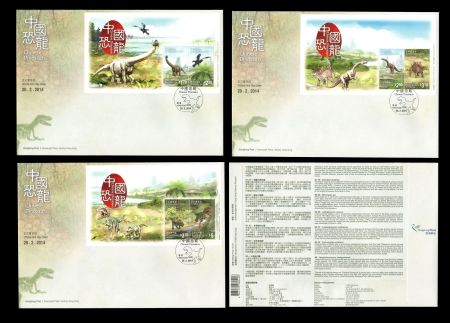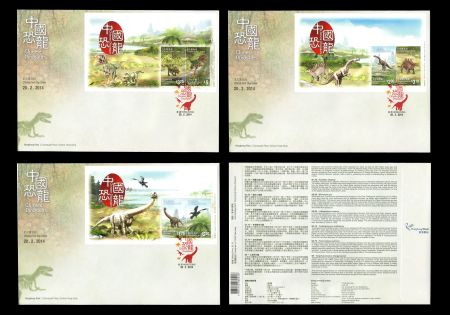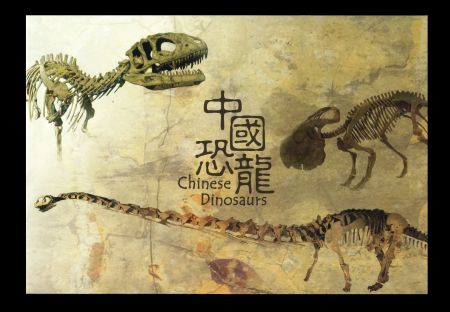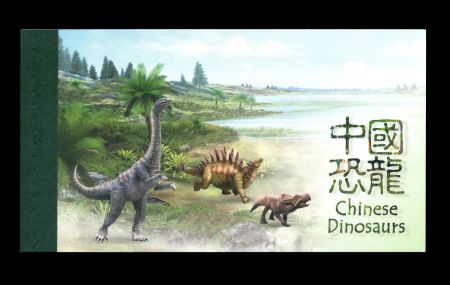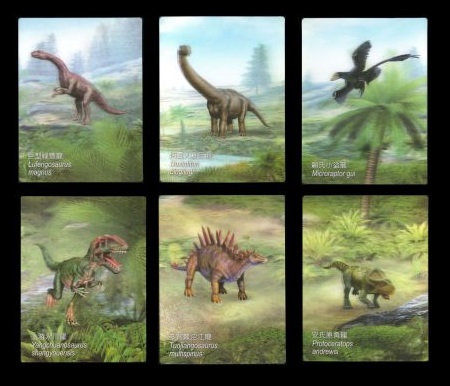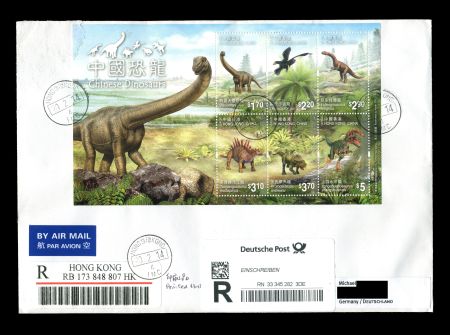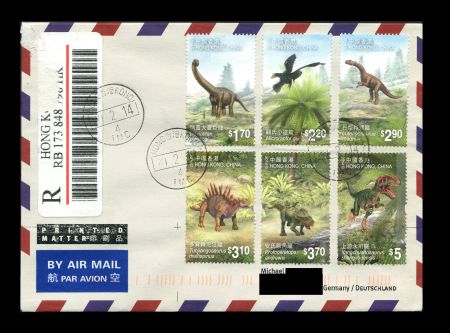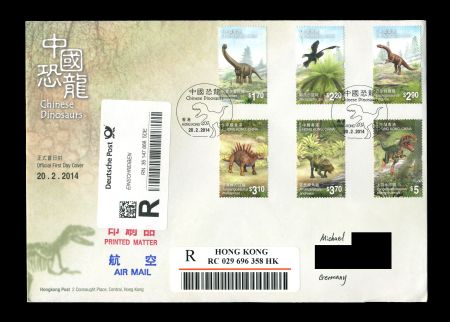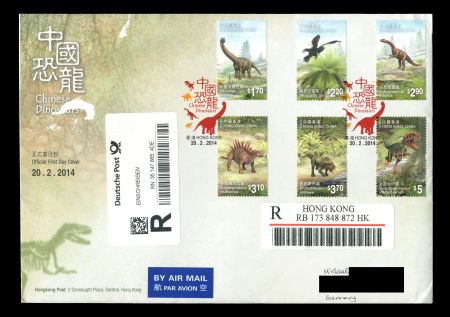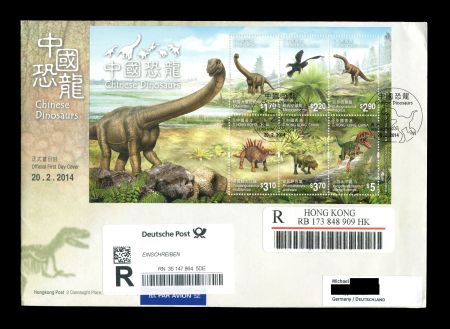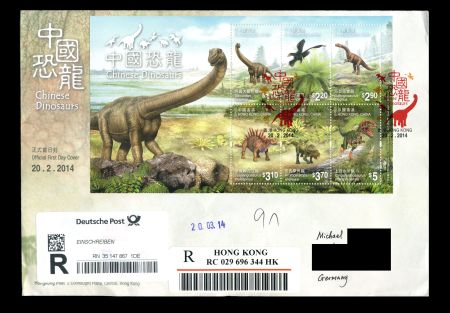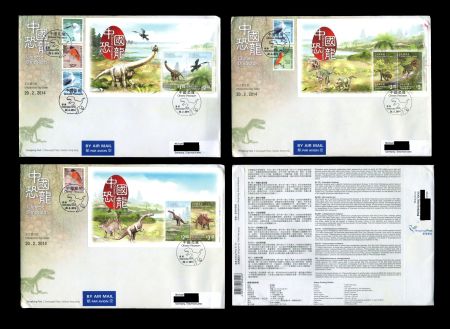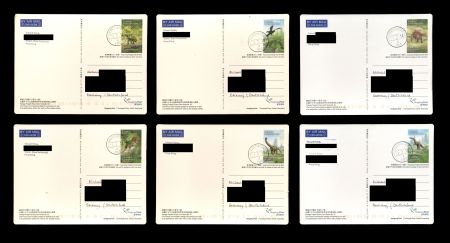Hong Kong 2014 "Chinese Dinosaurs"
| <prev |
| Issue Date | 20.02.2014 |
| ID | Michel: 1871-1876, Bl. 271; Scott: 1625-1630, 1630a; Stanley Gibbons: 1849-1854, MS1855; Yvert et Tellier: 1706-1711, BF251; Category: pR |
| Design | Tong Wai-Pang, Illustration: Keith YIP |
| Stamps in set | 6 |
| Value |
$1.70 - Daxiatitan binglingi $2.20 - Microraptor gui $2.90 - Lufengosaurus magnus $3.10 - Tuojiangosaurus multispinus $3.70 - Protoceratops andrewsi $5.00 - Yangchuanosaurus shangyouensisp |
| Emission/Type | commemorative |
| Places of issue | Hong Kong |
| Size (width x height) | stamps: 28 mm × 45 mm; Mini-Sheet: 170 mm × 100 mm |
| Layout | Sheets of 25 stamps, Mini-Sheet of all 6 stamps |
| Products | FDC x 1, Booklet x1. Presentation Pack x1 |
| Paper | Paper with security fibres |
| Perforation | 13.5 x 13.25 (one elliptical perforation on each vertical) |
| Print Technique | Lithography plus glow-in-dark effect |
| Printed by | Joh. Enschedé B.V., the Netherlands |
| Quantity | |
| Issuing Authority | Hongkong Post |
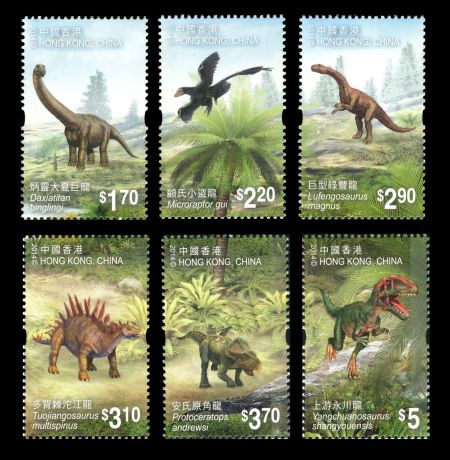
Throughout the extended history of the Earth, there comes a time when dinosaurs first appeared about 200 million years ago and became the ultimate rulers of the planet for 130 million years. Over long periods of time, the ancient landmass Pangaea broke apart into different continents as a result of plate tectonic movements. Dinosaurs evolved into a whole family of different species in order to adapt to the changing environment, but they ultimately could not escape from extinction and all disappeared from the Earth 66 million years ago.
Thanks to the efforts of paleontologists, today we can have a glimpse of how dinosaurs had lived and reigned from the large number of fossils unearthed. Dinosaur fossils can be found on all continents and more than 1,000 species have been named. Today, China has become one of the places in the world where most dinosaur species are discovered and many of them are unique.
At present, China has over 170 recorded dinosaur species. Hongkong Post issuesd a set of six special stamps on "Chinese Dinosaurs" which introduces six unique Chinese dinosaur species, with a view to enhancing the public's understanding of Chinese dinosaurs.
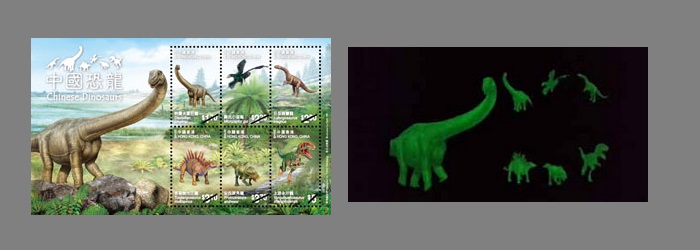 |
Daxiatitan binglingi was a gigantic herbivorous sauropod dinosaur in the Early Cretaceous Epoch (around 130 million years ago). Its fossils were discovered in the Lanzhou Basin in Gansu Province. Its name comes from the famous Bingling Temple near the origin of the fossils and the Daxia River, a branch of the Yellow River, which runs through the excavation site. With a total length of some 30 metres and a neck around 12.5 metres long, Daxiatitan binglingi lived in forests along the riverbank and fed mainly on tree leaves. It is one of the largest dinosaurs discovered in Asia. |
Microraptor gui, a carnivorous dromaeosaurid dinosaur in the Early Cretaceous Period (around 120 million years ago), was the most well-known kind of feathered dinosaurs. Its fossils were unearthed in western Liaoning Province. The species was named after the famous palaeontologist Gu Zhiwei. Microraptor gui was about 1 metre long with a massive tail more than half of its body length. It lived mostly in woods and had the ability to glide between trees. A batch of feathered dinosaur fossils, discovered in Liaoning Province in 2000 by researchers of the Chinese Academy of Sciences, provides evidence to support the theory that birds are descended from dinosaurs. |
||
Lufengosaurus magnuswas a herbivorous prosauropod dinosaur that lived in the Early Jurassic Period (around 180 million years ago). It was named after Lufeng County in Yunnan Province where the fossil was first discovered. About 6 to 7 metres long, its strong and powerful hind limbs enabled it to walk on two limbs, while its big tail helped to balance its body. Mostly living on the lakefront and swamp shores, Lufengosaurus consumed mainly the new growth of thick foliage. The first colossal fossil of Lufengosaurus was unearthed in China in 1938. It was the first dinosaur mounted in China and appears on a stamp ( China, 1958), where it was the first dinosaur to appear on a stamp. |
Tuojiangosaurus multispinus was a herbivorous stegosaurid dinosaur from the Late Jurassic Period (around 150 million years ago). Its fossil was discovered near River Tuo, Sichuan Province, from which the species gained its name. Tuojiangosaurus was 7 to 8 metres long, with a triangular head, two rows of upward spiked plates running down over its neck, spine and tail, and two pairs of outward pointing spikes at the end of its tail. Mainly living in forests, the species fed predominantly on low vegetation. The fossil of Tuojiangosaurus is the first well-preserved stegosaurus skeleton ever discovered in Asia on record. 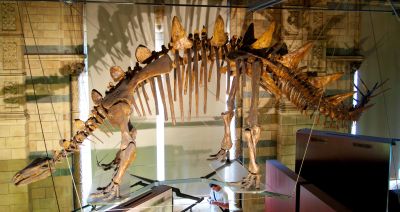 Image credit: Wikipedia, Photographer: Adam Russell from England |
||
Protoceratops andrewsi was a herbivorous ceratopsian dinosaur from the Late Cretaceous Period (around 75 million years ago). Its fossil were unearthed in the Gobi Desert, Inner Mongolia and it was named after the expedition leader, palaeontologist Roy Chapman Andrews. Protoceratops was about 2 to 3 metres long, with a slightly protruding nasal bone, a parrot-like beak, and a huge bony frill behind the skull that protected its neck and back. It usually lived in dense woods and fed on low-lying, ground vegetation. Extremely rich in remains of Protoceratops, China is one of the important excavation sites of Protoceratops fossils. |
Yangchuanosaurus shangyouensis was an enormous carnivorous theropod dinosaur from the Late Jurassic Period (around 150 million years ago). It was named after the excavation of the first fossil during the construction of a reservoir in Yongchuan, Chongqing. It was about 8 to 10 metres long, with sharp teeth and nimble forelimbs ending with three large and razor-sharp claws. Adept at living in hillocks and woods, it mainly preyed on small animals. The skeleton discovered in 1976 is the most intact fossil of a sizable theropod ever found in China. 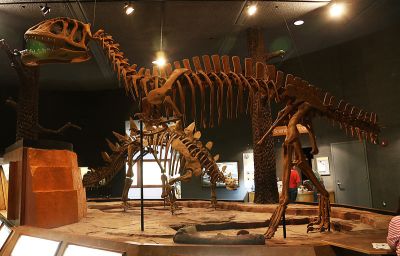 Image credit: Wikipedia, Jim, the Photographer from Springfield PA, United States of America |
A fascinating new series of exhibits on “Fauna and Flora” displayed at the Postal Gallery located on Ground Floor, General Post Office from 13 February 2014 to 4 May 2014.
This exhibition presents a retrospective of stamps and philatelic products on the common and native fauna and flora in Hong Kong, including the rare and precious species, released by Hongkong Post over the years, aiming to enhance public awareness of fauna and flora and cultivate public interest in local nature conservation. Stamps on similar themes issued by China Post and Macao Post will also be exhibited at the venue.
Furthermore, as a preview of “Chinese Dinosaurs” stamp issue to be released on 20 February 2014, stamps, souvenir sheet and associated philatelic products are also on display. To add philatelic attraction and fun to the exhibition, a brief introduction on the 6 dinosaurs portrayed in the new stamp issue “Chinese Dinosaurs” are presented also.
Products and associated philatelic items
References
Acknowledgements
| ||||||||||||||||||||||||||||||||||||||||
